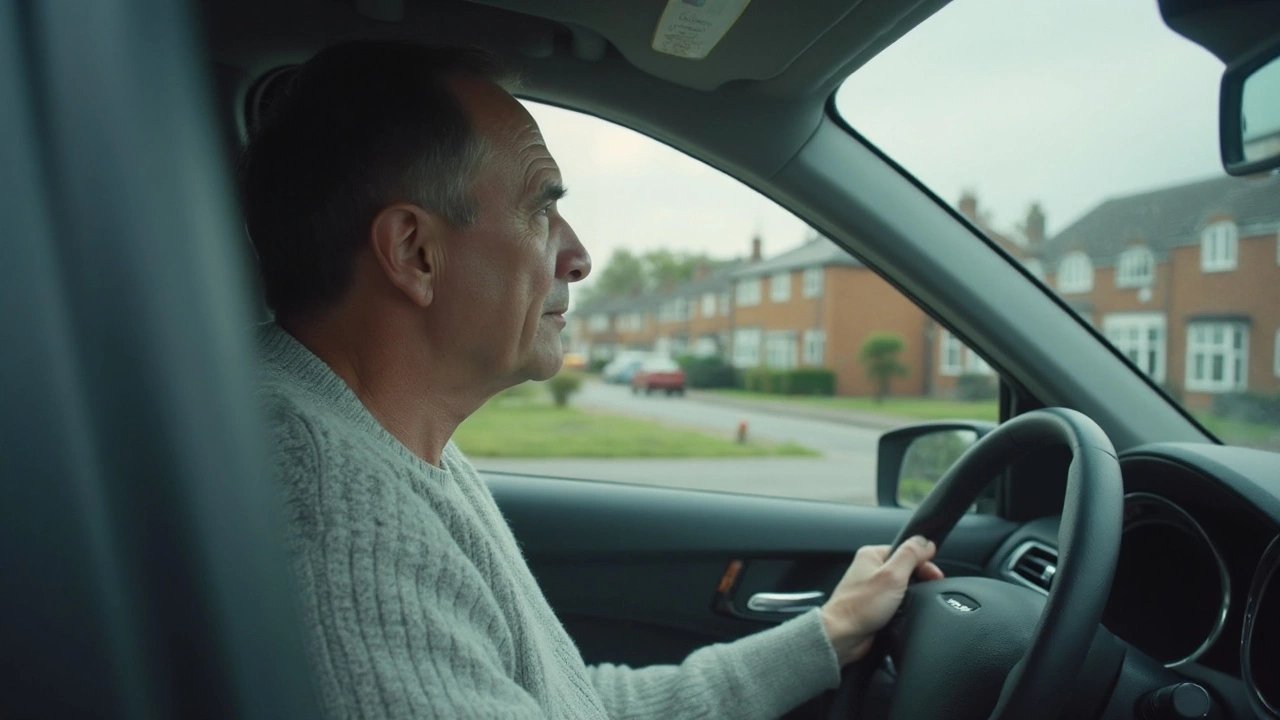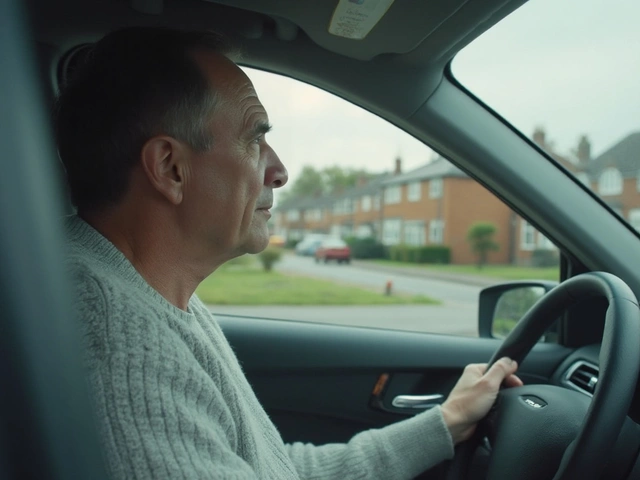Freshly tinted windows always look slick, right? But if you notice a weird haze, streaks, or tiny bubbles after the job, don't freak out yet. This is totally normal—at first. It’s just a sign your tint is in the process of curing, not a bad install.
The curing stage is when all that soapy water under the film dries out and the adhesive really grabs onto your glass. For most cars or home windows, curing can take anywhere from a few days to a few weeks. Tons of stuff messes with this, like weather (hot and sunny makes it cure faster, cold and damp slows it down), how thick the film is, and even if you park outside or in the shade.
If you’re itching to clean or roll down your windows, hold up. Tugging or scrubbing too soon is the number one way people mess up new tint. The wait is worth it. You want that smooth, bubble-free look to last, so knowing the right signs of a fully cured tint will save you regrets and extra costs.
- Why Curing Is So Important
- What Impacts Tint Curing Time?
- How to Spot a Fully Cured Tint
- Common Myths About Tint Curing
- Mistakes to Avoid While Waiting
- Quick Troubleshooting If Something Looks Off
Why Curing Is So Important
Getting your window tint put on is just the first step. The curing period is what makes or breaks the whole project, literally. If you use your windows too soon, or ignore issues while the tint is still wet underneath, your film can peel, bubble, or look cloudy for good. You want the tint’s adhesive to fully bond with the glass, locking out moisture and preventing ugly spots from popping up down the road.
Right after install, that moisture between the glass and film needs time to disappear. If it doesn't cure right, you might be looking at problems like shifting, edges peeling up, or whole spots losing adhesion. Way too many folks end up having to redo their tint just because they rushed the process.
- Proper curing means fewer bubbles and a smoother finish.
- Full curing helps the tint last much longer, so you don’t have to pay to replace it early.
- Without curing, tint will be way more likely to fade, crack, or turn purple (yep, even premium films).
Here's a quick look at what happens if you skip the patience test:
| Issue | What Causes It | How Curing Prevents It |
|---|---|---|
| Bubbles | Trapped moisture, rushing window use | Evaporation seals film to glass |
| Edge Peeling | Touching or rolling windows too soon | Adhesive sets and locks film tight |
| Hazy or Foggy Look | Incomplete moisture escape | Drying out clears up appearance |
| Premature Fading | Poor bonding, weak spots | Full cure strengthens UV block |
If you want your window tint to look sharp for the long haul, stay patient. That curing period is key—think of it as the final insurance for your time, money, and sanity. It might take longer during colder months or on thicker films, but waiting it out always pays off.
What Impacts Tint Curing Time?
There’s no magic timer for when your tint is done curing. Different things can make the whole process faster or slower—some you can control, and some you can’t.
First up, weather is a big player. Hot, sunny days are perfect for curing because heat and sunlight help the moisture under the film dry out. If you live somewhere humid or cold, expect your windows to need more time—sometimes double.
- Window tint type: Dyed films generally cure quicker than ceramic or metallic ones, which are a bit thicker.
- Window location: Rear windows tend to cure slower, especially if your car sits in the garage all day. Front side windows? They get sun and heat, so they speed ahead.
- Glass thickness: Thicker glass holds the cold longer, slowing the drying process. Thin windows will cure up quicker.
- Ventilation: Fresh air helps, so cracking your windows (once it’s safe) or using a fan indoors speeds things up.
How the tint was installed also matters. Too much slip solution (that soapy water mix) under the film means a longer drying time. Pro installers usually know just how much to use, but DIY jobs? People tend to overdo it, so patience is key if you went the home route.
And here’s something a lot of folks miss—parking location. Leave your car to bake in the sun and that film will cure fast. But keep it parked in the shade, and you’ll be waiting around. The same goes for tinted home windows facing away from the midday sun.
The short version: warm, dry, and sunny equals happy, cured tint. Cold, damp, and shady means grab a book—you’ll be waiting a bit longer.
How to Spot a Fully Cured Tint
The tricky thing about window tint curing is there’s no dramatic moment when everything just looks perfect. But, there are some clear signals you can check. When a tint is fully cured, you won’t see bubbles, streaks, or that foggy look anymore. It should look smooth, clear, and tightly stuck to the glass. The film will stop shifting if you press gently near the edges.
The exact curing time is usually written on the paperwork from your installer or the product itself. Most brands say to expect about 3 to 5 days in hot weather and up to four weeks during rainy or cooler months. If you can, leave your vehicle out in the sun—glass heats up and speeds up the drying, sometimes by days.
- No tiny bubbles left—even the barely-there ones have flattened out or vanished.
- No cloudy or milky-looking places. If your tint still looks foggy, it’s not ready yet.
- The edges are sealed tight. You can barely fit a fingernail between the tint’s edge and the glass if you try (don’t actually pick at it, though).
- No shifting or moving when you press lightly on the film.
- Windows can be cleaned with a soft cloth and there’s zero drag or peeling.
If you find yourself squinting and can’t tell, try checking the window tint from outside on a bright, sunny day. Any flaws or spots that aren’t fully cured will pop more in direct sunlight. Still not sure? Reach out to your installer or hit up their shop for a quick check—they’d rather answer your question than fix a mess.

Common Myths About Tint Curing
There’s a boatload of bad advice online about window tint curing. You’ll hear old-school tips from buddies at the car wash or maybe see random claims on forums, but a lot just aren’t true. Let’s bust a few big ones so you don’t end up frustrated or damaging your new tint.
- Myth: All tints cure in three days, max. Nope. In reality, how fast your tint cures depends on the film type, weather, and even the direction your windows face. In hot, dry weather, you might hit three days, but when it’s chilly or rainy? It can push past two weeks.
- Myth: Bubbles or streaks mean something went wrong. Not always. Small bubbles and a cloudy look are super common the first week or so. This usually clears up on its own as water and adhesive settle.
- Myth: You can speed things up with a hair dryer or heater. Heating up your glass can actually do more harm than good, possibly warping or peeling the film. Let time and nature do the job.
- Myth: I should clean the new tint right away. Cleaning too early is the fastest way to ruin your tint. Wait until it’s fully cured—just check the guide your installer gave you, or play it safe and give it a month if you’re unsure.
Here’s how long typical films take to cure depending on weather:
| Tint Type | Sunny, Warm | Cool, Damp |
|---|---|---|
| Dyed | 3-5 days | 10-14 days |
| Metallic/Ceramic | 5-7 days | 14-21 days |
| Thick Security Film | 7-10 days | 3-4 weeks |
Every install is a little different, but if you ignore these myths and just stay patient, your tint will look great for the long run. If anything feels off after what should be a normal cure time, snap a photo and check in with your installer—most are happy to help or reassure you.
Mistakes to Avoid While Waiting
People make some classic mistakes when they get their windows tinted, and most of them happen because they’re just too impatient for the tint to cure properly. Trust me—rushing it will probably leave you with damage or bubbles, and then you’re back at the shop wasting more money.
Here are the big no-no’s to watch out for while your tint is curing:
- Rolling down your windows: Even if the instructions say your tint is dry to the touch after a day or two, don’t roll them down for at least 3-5 days. If it’s humid or cold, double that time. Rolling down too early almost always lifts the tint or causes peeling.
- Washing the inside of your windows: Water and cleaning products can ruin the adhesive before it’s ready. Wait until you’re sure every bit is cured—usually about two weeks, minimum—before you even reach for a paper towel.
- Using sharp objects or scraping at bubbles: Some bubbles and haziness are normal while the film cures. Digging at them with your nails or a scraper usually shreds the film. Let them be—they’ll mostly disappear as the film completely seals.
- Parking in bad spots: Avoid places where water or debris can get on your fresh tint, like under leaky gutters, sprinklers, or trees dropping sap. Excess moisture and gunk slow curing and make the film lift.
- Leaving windows up all the time: If it’s safe and the weather’s good, crack your windows a tiny bit to let moisture escape. But only if you know they won’t move or get bumped. Proper airflow helps speed things along.
It’s easy to get impatient—especially when your ride looks so much better with new window tint. Just give it the right time and care, and you won’t have to mess with costly fixes later.
Quick Troubleshooting If Something Looks Off
Ever looked at your windows after a tint job and thought, “Uh-oh, did they mess this up?” Before you panic and call the shop, there are some things you can check yourself. Most of the time, problems right after tinting aren’t permanent and can be resolved without a big headache.
Here’s what matters: a few bubbles or a hazy layer during the first week or so is totally normal. It doesn’t mean you got ripped off; it just means the adhesive or leftover moisture is still doing its thing. But if you spot anything that looks strange after the normal curing time (usually 1-4 weeks, depending on weather), it’s time to take a closer look.
- Window tint still looks milky or bubble-heavy after a month? That’s an issue. Excessive haziness can mean trapped water, a poor squeegee job, or even bad adhesive.
- Big bubbles that don’t shrink after a couple of weeks? Those probably aren’t going anywhere on their own. Small, pin-sized ones usually disappear, but big clusters or creases need pro attention.
- Edges peeling or film lifting at the corners? That’s a sign the tint isn’t sticking. Dirt under the film, oily glass, or a rushed install could be to blame.
- Weird purple or brown patches? Cheap tint can fade or discolor fast, especially if the product skipped UV protection.
If you see any of these, here’s how you can troubleshoot:
- Check the time since installation. If it’s only been a few days, give it a bit longer, especially if the weather’s been cool or rainy.
- Look at where problems appear. Just at the corners? That suggests peeling. All over the glass? That might be moisture or adhesive issues.
- Try not to poke or peel the film. This can make things worse. Document the issue with photos instead.
- If a problem stays the same or gets worse after about 30 days, reach out to your installer. Good shops guarantee their work—a decent warranty is pretty standard.
For peace of mind, here’s a quick table to help sort out what’s normal and what’s not by time:
| Symptom | Week 1 | Week 4+ |
|---|---|---|
| Small bubbles | Normal | Not normal |
| Hazy look | Normal | Should be gone |
| Lifting or peeling | Watch | Contact installer |
| Discoloration | Odd, but possible | Definitely not normal |
I read this from the International Window Film Association:
"During the drying period, small water bubbles and a cloudy look may appear as moisture evaporates through the film – this is not a flaw and will eventually disappear."So don’t sweat the weird stuff right away. But if it lingers, don’t wait—take action while your warranty is still fresh.




